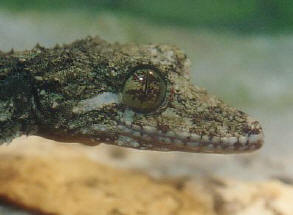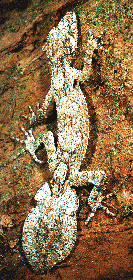Northern Leaf-tailed Gecko

Photo: Courtesy of Damon Ramsey
BSc.(Zool) Biologist Guide
Northern Leaf-tailed Gecko (Phyllurus cornutus) Characteristics: - It is named for its large, leaf-shaped tail which can be dropped and regrown.
- This gecko lacks the adhering toe disks of many gecko species. Instead as an arboreal species, it has clawed toes which would assist in climbing over rough surfaces.
- Leaf-Tail geckos may be various shades of brown or green with a mottling that looks so much lichen that they can be very difficult to distinguish from the trees on which they live. (Source: Environmental Protection Agency)
Habitat: This is a tree-dwelling nocturnal animal of sluggish movement and thus relies on its camouflaged appearance to avoid detection by predators.They may be found in rainforests and wet sclerophyll forests beneath loose tree bark or in tree crevices during the day and active on trees, rocks and on the forest floor at night.Predators: - Predators include owls, rats and snakes.
Diet: - The leaf-tail gecko is generally found, at night, perched head down on a large rainforest tree waiting to ambush its prey - large invertebrates such as spiders and cockroaches. (Source: Department of Environment)
Mechanisms to avoid predation:  - This gecko has developed a tail which looks like a leaf and is similar in shape and size to that of its own head. When disturbed the gecko raises and moves its tail to attract the predator to its tail (as opposed to its head). If the predator then grasps the fatty tail, the gecko is able to drop it and escape.
- females lay 2 soft shelled eggs
Viewing Opportunities: - This gecko is extremely difficult to see unless it is on a background unless it is on a wall or light-coloured tree, where it cannot utilise the advantage of it's camouflaged appearance.
- Can be found on the rainforest floor under fallen bark from dead tree branches.
Additional Photos
Leaf-tailed Geckos of the Lamington National Park.
|
